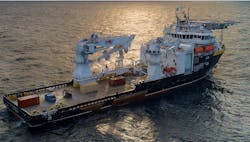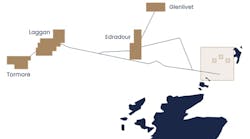Offshore staff
HOUSTON – Oceaneering International Inc. has taken delivery of the subsea construction support vessel Ocean Evolution.
The vessel has completed sea trials and received all necessary ABS and US Coast Guard certifications. It is currently in Port Fourchon, Louisiana, completing final outfitting and preparing for project work scheduled to begin in June.
Measuring 353 ft (108 m) long, 72 ft (22 m) wide and weighing 6,900 tons, theOcean Evolution is an ABS class DP-2 subsea multi-service vessel built in the US under Jones Act requirements for coast-wise trade of personnel and equipment. The vessel has accommodations for 110 persons, a helideck, and a working moonpool measuring 23 ft x 23 ft (7 m x 7 m).
The vessel’s 12,595-sq ft (1,170-sq m) steel-constructed deck is designed to carry heavy loads and equipment. The deck is rated to support 10 metric tons/sq m with a total cargo carrying capacity of 1,900 metric tons.
It is equipped with a 250-metric ton active heave compensated main crane with a 13,000 ft (4,000 m) working depth capacity. This crane has a special lifting mode that allows heavy lifts with alternate reeving of the boom eliminating the jib that provides increased hook heights of 118 ft (36 m) above the main deck. This, the company said, provides the ability for crews to lift tall wellheads, large pin piles, and other oversized equipment off the deck using the maximum lifting capacity of the crane. A second auxiliary crane on deck adjacent to the working moonpool is capable of 40 metric tons for lifting and handling of equipment on deck and to water depths of 600 ft (180 m).
TheOcean Evolution features a layout bridge, configured with port and starboard redundant control stations. These control station locations are said to provide bridge officers and DPOs a better view of crane operations, ROV deployment and simultaneous operations with other vessels and platforms on each side of the vessel.
The vessel has five low-emission EPA Tier 4 diesel engines with a combined generating capacity of 16 MW on a three-bus system. The Tier 4 rating is the EPA’s strictest emission requirements for non-road diesel engines, the company said, and the combination of five engines and third bus provides enough excess capacity to allow full capability and redundancy of the vessel if one engine is down for maintenance.
TheOcean Evolution features enhanced station keeping capabilities, which allows it to maintain position even during extreme weather conditions. The vessel’s position is held using two tunnel thrusters and a drop down thruster in the bow along with two Azipull thrusters in the stern. Props on the propulsion systems can be turned 360⁰ and were designed to optimize dynamic positioning of the vessel.
According to the company, the vessel’s design and construction were done with well stimulation and light well intervention in mind as a key capability. The underdeck storage capacity of up to 109,000 gal (413 cu m) of special products maximizes use of the critical deck space for pumping and intervention equipment. The vessel’s layout and safety systems meet ABS class requirements for a special well stimulation and well intervention notation.
It is also equipped with two Oceaneering work-class ROVs. One 220-hp Millennium Plus and one 250-hp NEXXUS systems are onboard each with active heave compensated launch and recovery systems installed in a custom indoor hanger for port and starboard launch. Integrated survey and communication systems round out permanently installed equipment that provide positioning and data services for all operations.
04/22/2019



